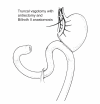Small intestinal bacterial overgrowth: a comprehensive review
- PMID: 21960820
- PMCID: PMC3099351
Small intestinal bacterial overgrowth: a comprehensive review
Abstract
Small intestinal bacterial overgrowth (SIBO), defined as excessive bacteria in the small intestine, remains a poorly understood disease. Initially thought to occur in only a small number of patients, it is now apparent that this disorder is more prevalent than previously thought. Patients with SIBO vary in presentation, from being only mildly symptomatic to suffering from chronic diarrhea, weight loss, and malabsorption. A number of diagnostic tests are currently available, although the optimal treatment regimen remains elusive. Recently there has been renewed interest in SIBO and its putative association with irritable bowel syndrome. In this comprehensive review, we will discuss the epidemiology, pathogenesis, clinical manifestations, diagnosis, and treatment of SIBO.
Keywords: Bacterial overgrowth; antibiotics; bloating; diarrhea; motility disorders; small intestinal bacterial overgrowth.
Figures





References
-
- Fine D, Schiller LR. American Gastroenterological Association Medical Position Statement. Guidelines for the evaluation and management of chronic diarrhea. Gastroenterology. 1999;116:1464–1486. - PubMed
-
- Corrazza GR, Menozzi MG, Strocchi A, et al. The diagnosis of small bowel bacterial overgrowth: reliability of jejunal culture and inadequacy of breath hydrogen testing. Gastroenterology. 1990;98:302–309. - PubMed
-
- Issacs PE, Kim YS. Blind loop syndrome and small bowel bacterial contamination. Clin Gastroenterol. 1983;12:395–414. - PubMed
-
- Bouhnik Y, Alain S, Attar A, et al. Bacterial populations contaminating the upper gut in patients with small intestinal bacterial overgrowth syndrome. Am J Gastroenterol. 1999;94:1327–1331. - PubMed
-
- Parlesak A, Klein B, Schecher K, et al. Prevalence of small bowel bacterial overgrowth and its association with nutrition intake in nonhospitalized older adults. J Am Geriatr Soc. 2003;51:768–773. - PubMed
LinkOut - more resources
Full Text Sources
Other Literature Sources
Medical
